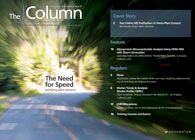Antiquus illness
A team of scientists has produced evidence that the pathogen, Mycobacterium tuberculosis, was present over 17000 years ago in a skeleton of extinct Bison antiquus.
A team of scientists has produced evidence that the pathogen, Mycobacterium tuberculosis, was present over 17 000 years ago in a skeleton of extinct Bison antiquus.1 The study followed a DNA report that was performed 10 years ago and suggested that the skeleton was the oldest known case of tuberculosis.
In the most recent study the team used fluorescence high-performance liquid chromatography (HPLC) on the same two samples from the bison. They were able to indicate the presence of mycolic acids but they were degraded and could not be precisely correlated with tuberculosis. However, C29, C30 and C32 mycocerosates and C27 mycolipenates, which are typical of the Mycobacterium tuberculosis complex, were recorded when negative ion chemical ionization gas chromatography mass spectrometry (NICI-GC–MS) was used. These findings were supported by the detection of C34 and C36 phthiocerols, which are usually esterified to the mycocerosates.
The team deduced that they had found conclusive evidence for the presence of tuberculosis in the bison samples. They also concluded that tuberculosis could now potentially be identified in the absence of obvious bone lesions. Of particular interest is that there is not a proven human tuberculosis sample older than 9,000 BP (Before Present), which suggests that the disease may have originated in animals before moving across to humans. More work needs to be undertaken before this hypothesis can be supported or disproved.
1. O.Y-C Lee et al., PLoS One 7(7): e41923 (2012).
This story originally appeared in The Column. Click here to view that issue.
Regulatory Deadlines and Supply Chain Challenges Take Center Stage in Nitrosamine Discussion
April 10th 2025During an LCGC International peer exchange, Aloka Srinivasan, Mayank Bhanti, and Amber Burch discussed the regulatory deadlines and supply chain challenges that come with nitrosamine analysis.











